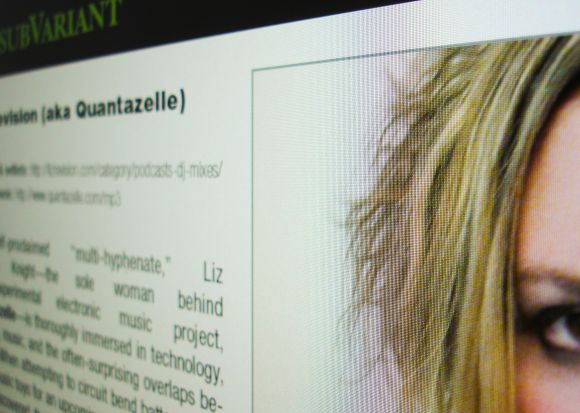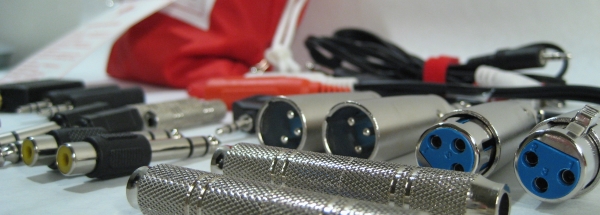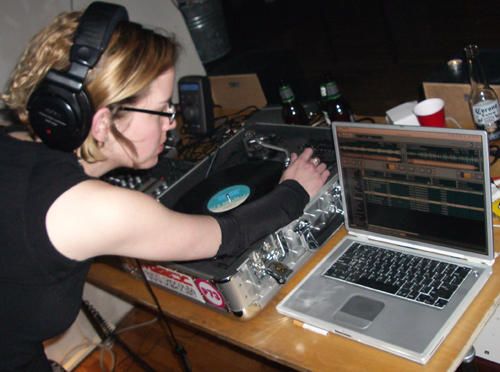
Taking steps from the studio to live performance can often be challenging, even for experienced musicians. Playing electronic and computer-based music often doesn’t make it any easier. It can be even harder to find the right venues, figure out how to present your performance persona, and keep the technology working, compared to someone grabbing an acoustic guitar and showing up at singer-songwriter night. But regardless of genre, the toughest part for musicians is often just getting started.
With that in mind, CDM contributor Liz McLean Knight, aka Quantazelle, has compiled some of what she’s learned both from booking acts and getting herself booked as a laptop-based musician, working the scene in Chicago, Illinois. She’s got a lot of tips specific to electronic and digital music, as well as some general strategies for successfully promoting yourself. See if this helps get you going, and feel free to ask questions or add some comments and experience of your own. -PK
1. Get a mini-press kit together specifically for getting booked. Include a brief musical and personal history, a few terse sound bites on the music itself (quotes you can cull from reviews other people have written, or you write a few descriptive lines yourself), and other information that shows why people will or need to come out to see you perform live. Find something interesting about yourself or your process and talk briefly about it. Press people love interesting aspects about their potential stories, so if you’re a neurosurgeon who’s dabbling in digital audio and donating a percentage of your gig revenue to a charity you should highlight it. If you’ve had some significant press exposure or have played in a well-regarded club or with a higher-profile artist, you should definitely mention it. Keep it short though—no more than a single page printed or PDF-ified. Here’s my single-sheet bio from subVariant that you can use as an example.
Ed. note: I’ll reinforce what Liz is saying; since I write regularly for Keyboard Magazine I get an absurd number of press kits. (I can’t imagine what it’d be like if I actually wrote artist coverage most of the time.) Press kits are pretty much all awful: too long, over-hyped and impossible to read, and that’s often from big PR firms. As an artist yourself, you can probably do better: skip straight to what’s really important in the music, and anything unusual and personal about you. -PK
2. Let them know what you sound like live. The key word is live. A pure demo CD with a few representative tracks is good, but promoters looking for people to book are often aiming for a cohesive night with a certain “sound” and want to see if you can fit into their vision. If you’ve recorded a previous live performance, burn it to a CDR and post it online. It’s not necessary to record the sounds of the crowd (unless they’re consistently, vocally freaking out and showing up in large numbers). If you haven’t got a live recording, do a mock performance in the safety of your bedroom similar to what you’d do live. Put your best track first to catch the listener’s attention quickly. Make sure your contact info is on the CD itself in case the promoter loses the other material.
3. Make sure that you will avoid dead air. Few things make a promoter’s stomach kick into panic mode like the sudden absence of music. It’s particularly relevant with laptop-based performance since no one can tell if you’re having potentially catastrophic technical difficulties or just being slow in loading up the next track. If the venue you’re considering is very casual, you can likely get away with it, but you should at least try to engage the audience to make everyone feel comfortable. Aim to make a cohesive set so you’ll be ready for playing bigger clubs.
If you think it’s impossible to to have a cohesive set with all your DSP-ing, I would mention here that Akufen played a two hour set in Detroit for the Movement festival using only one file in Ableton Live—he just slowly worked from the left side to the right, selectively turning on and off clips as he went. In one of my own early sets I dragged my entire desktop system (so heavy, but I was thankful for the help of muscular men) along with my laptop and a 4-channel Gemini DJ mixer to a show so I could run some custom ambient patches on Reaktor and while I loaded up the next file on my laptop. Then I found a sound card with multiple channels (The Echo Indigo DJ PCMCIA card) and had no need to drag along an additional 150 pounds of geriatric computing power. You’ve got to figure out your own solution along these lines to avoid dead air. Trust me, you’ll have a much easier time. Ed.: We could easily fill another article with ways to do this in Ableton alone, and probably should do just that. -PK
4. Do some research on venues, and start small. Coffee shops are generally a good bet if you’re just getting started since they’re very casual and the audience will be more forgiving of mistakes or gear failures. In one of my very early performances I was using a little modular synth / tracker program called Buzz and was playing around with it while my track was running when suddenly my laptop froze and started looping an ear-splitting screech. I had to physically remove the battery before I could force it to shutdown, and I was playing to a full room of about 50 who all became quiet and stared at me expectantly. Fortunately I had a CD to hand to the sound guy to play, but I hid in the bathroom for a while. Performing in a more casual coffee house instead (until I found a better tool than Buzz) would have saved me some embarrassment. You might also consider neighborhood-type bars, or restaurants that already have a pre-existing audience that regularly attends. This puts less pressure on you to bring out a crowd, but still lets you perform in front of live people as well as get more exposure.
5. Find your contact person, and respond quickly. If you’re ready to move beyond coffee shops and the low-key places, go and visit some clubs that you think you will be a good fit with. Try and find the booker or the promoter in charge of the night, introduce yourself, and give them your mini press kit and demo CD. If they’re not around or you can’t figure it out, ask the bartender or bouncer who books the club who to contact and what time they accept phone calls for booking. When you’ve got that information, call within those hours and pitch yourself and your act. If they seem interested, ask if you can send them a demo. Then do it right away—preferably so it gets there the next day. American readers, if the club is in the same area as you, USPS Priority Mail usually gets it there by the following day, affordably. Otherwise, check out DHL Next Day Air Saver (3:00pm). It’s usually the least expensive option for next day delivery. [International readers may have good local next-day options; I haven’t sent next-day within other countries, only between different countries. -Ed.] If you haven’t heard back from them within a few weeks, call or email once to see what they thought of your demo.
At Ramp Chicago we get tons of emails and MySpace messages from people who want to play at our nights at Sonotheque, so we have a policy that if a local act wants to play (or provide video) they have to come to one of our nights and physically hand us a CD or DVD demo. This lets us know who’s serious about playing and makes our jobs a bit easier. Some people prefer this and others would rather use the phone / email method above, so find out before you submit something.
6. Agree on details before the gig. When you’ve found someone who wants to book you, make sure you and the promoter understand what you need from each other. Get the load-in time, your estimated performance time slot, and set duration. While more established artists have a formal contract and a guarantee (their minimum payment) along with either a percentage of the door (ticket sales / cover charges) or a percentage of the till (the revenue from drink sales during the night), you will likely be making these arrangements informally over email, the phone, or in person. Often a new performer will be playing for free or for drinks, but you might get lucky. You will probably need a table, access to a power strip, and maybe even a chair. Ask for these things in advance, because strangely enough, some people don’t realize you need a horizontal surface to put your laptop on that’s not the floor—especially places that primarily book bands.
7. Invite everyone you know. This part is really key. A promoter or booker is hoping you will bring lots of people who need alcohol, and that their business will be the one who sells it to them. If you can show the promoter or booker that you can draw a crowd, he or she will definitely keep you in mind for future gigs. You do have a mailing list, don’t you? If not, get started, but make sure you have a link at the bottom of every email message where the recipient can unsubscribe if they so desire. Ask the promoter for fliers if there are any so you can help get the word out—this will also demonstrate to them that you’re committed to bringing crowds out.
8. Bring some light. Bring a little flashlight to help you crawl around in the dark to plug in cables. If you’re twisting knobs on gear you should consider bringing a small battery-powered table lamp (since you will probably already have enough cables to deal with already). I’ve got a few silver lightweight LED lamps that are only about US$10.

9. Bring audio adapters. You never know what you’re going to have to deal with in terms of the house sound system or how the venue expects you to feed into it. I designed the Electronic Musician’s Emergency Adapter kit ($65) to be a Swiss army knife of audio adapters, modeled after the one I carried around to shows for many years. Another good tool is a ground loop isolator ($12-$18) to prevent that nasty buzzing that often happens with a laptop not running on its battery. If you have a lot of gear, you should make a checklist and look it over before you walk out the door–you’ll be far less stressed when you’re confident you have everything you’ll need.
10. Bring CDs to give away or ones to sell in case people ask for one. Make sure your project name is on the CD itself, along with your contact information and a URL of your website, Myspace page, or whatever you’ve got. It’ll help you make new friends and fans and you might even get a recording offer or an invitation to play your next gig.
Good luck!
Previously:
Getting Publicity: Start With a Good Name for Your Project
